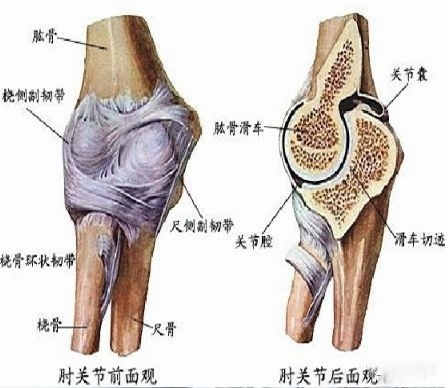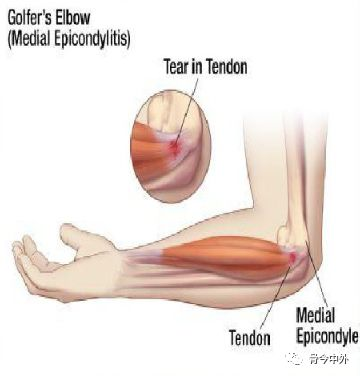Definition of lateral epicondylitis of the humerus
Also known as tennis elbow, tendon strain of the extensor carpi radialis muscle, or sprain of the attachment point of the extensor carpi tendon, brachioradial bursitis, also known as lateral epicondyle syndrome. Traumatic aseptic inflammation of the soft tissues surrounding the lateral epicondyle of the humerus due to acute, chronic injury.
Pathogenesis
It is closely related to occupation, especially in workers who often rotate the forearm and extend and flex the elbow and wrist joints. Most of them are housewives, carpenters, bricklayers, fitters, plumbers, and athletes.
Dissect
The prominences on both sides of the lower end of the humerus are the medial and lateral epicondyles, the medial epicondyle is the attachment of the common tendon of the flexor muscles of the forearm, and the lateral epicondyle is the attachment of the common tendon of the extensor muscles of the forearm. The starting point of the brachioradialis muscle, flex the forearm and slightly pronate. The starting point of the extensor carpi radialis longus, extensor carpi radialis brevis muscle, extensor digitorum majoris, extensor digitorum propria of the little finger, extensor carpi ulnaris, supinator muscle.

Pathogen
The onset of the condyle is caused by acute sprain and stretching, but most patients have a slow onset and generally have no obvious history of trauma, and it is more common in adults who need to repeatedly rotate the forearm and extend the wrist forcefully. It can also be strained or sprained due to repeated dorsal extension of the wrist joint and excessive stretching of the wrist tendon at the attachment of the lateral epicondyle of the humerus when the forearm is in the pronation position.
Pathology
1.Due to repeated injury, the lateral epicondyle of the muscle fiber is torn and hemorrhaged, forming a subperiosteal hematoma, and then organizing and ossifying, resulting in periosteitis and bone hyperplasia of the lateral epicondyle of the humerus (mostly in the form of a sharp edge nodule). Pathological tissue biopsy examination is hyaline degeneration ischemia, so it is also called ischemic inflammation. Sometimes it is accompanied by a tear of the joint sac, and the synovial membrane of the joint is proliferated and thickened due to long-term stimulation by the muscle.
2.Tear at the extensor tendon attachment point.
3. traumatic inflammation or fibrohistolitis of the annular ligament.
4. bursitis of the brachioradial joint and extensor common tendon.
5.Inflammation of the synovium of the humerus and radial joint caused by the intercalation of the humerus and the small head of the radius.
6. Relaxation of the humerioradial ligament and mild separation of the proximal radial-ulnar joint can also occur, resulting in dislocation of the radial cephalic head. These pathological changes can cause muscle spasms, localized pain, radiating pain from the extended wrist muscles to the forearm.
Clinical presentation
1.The pain on the outside of the elbow joint is aggravated when pronation, especially when rotating the back extension, lifting, pulling, ending, pushing and other actions, and radiating downward along the wrist extensor muscle. At the beginning, I often feel pain and weakness in the injured limb, and gradually develop pain on the outside of the elbow, which is mostly aggravated with the increase of exercise. (The nature of the pain is soreness or tingling)
2.It is aggravated after exertion and relieved after rest.
3.Forearm rotation and weakness in holding objects, and even falling with objects.

Signs
1.Lateral humeral epicondyle The posterolateral aspect of the lateral epicondyle of the humerus, the space of the humeral-radial joint, the cephalic cephalic and the lateral edge of the radial neck condyle can be palpated, and the musculosis and flesh tissue on the radial side of the upper forearm can also be palpated with mild swelling, tenderness or stiffness. Sometimes sharp edges of hyperostosis can be felt at the lateral epicondyle of the humerus, and they are very tender.
2.The Mills test is positive. Bend your forearm slightly and make a half-fist, flex your wrist as much as possible, then fully pronate your forearm and straighten your elbow. If pain occurs on the lateral side of the brachioradial joint when the elbow is straightened, it is positive.
3.Positive extensor resistance test: the patient clenched his fist and flexed his wrist, and the examiner pressed the back of the patient’s hand with his hand to make the patient resist resistance and extend the wrist, such as the pain on the outside of the elbow is positive.
4.X-ray examination may occasionally show periosteal irregularity, or a small number of calcification points outside the periosteum.
Treatment
Conservative treatment:
1. Stop local training of stimulation early, and some patients can be relieved by rest or local plaster immobilization condyle.
2.Massage therapy, use pushing and kneading techniques to relieve the spasm and pain relief of the extensor muscles of the forearm, and then use point pressure and kneading techniques on the lateral epicondyle of the humerus and nearby pain points.
3. Tuina therapy, the patient sits. The doctor uses gentle rolling and kneading to act on the back and outside of the elbow and reciprocating along the dorsal side of the forearm. The doctor uses the tip of the thumb to press and rub Ah Shi (lateral epicondyle), Qi Ze, Quchi, Hand Sanli, Waiguan, Hegu acupoint, etc. The patient is seated, and the doctor plucks the patient’s starting point of the extensor carpi and extensor carpi longus and brevis radialis. Pull and stretch, live elbows. Finally, use the thenar rubbing method to rub the lateral epicondyle of the elbow and the extensor muscles of the forearm, and the local heat is used to the degree.
4. Drug treatment, oral non-steroidal anti-inflammatory drugs in the acute stage.
5. Occlusive treatment: glucocorticoids (such as compound betamethasone injection) are injected into the tender point and injected into the tendon insertion point and subaponeurosis space (less than or equal to 3 times), which can play an anti-inflammatory and analgesic effect, and compound betamethasone and ropivacaine or the compatibility with levobupivacaine are currently recognized as fast-acting, long-acting, high anti-inflammatory titer, and the safest, longest blocking time, least toxic reaction and lowest pain rebound drug compatibility for local occlusion.
6. Acupuncture treatment, the incision is close to the bone surface to peel off the adhesion soft tissue around the bone process, dredge the extensor wrist muscle, extensor finger muscle common tendon and supinator tendon, and pull out the knife with a sense of looseness. Surgical treatment: suitable for patients who do not respond to conservative treatment.
1. Body &Meleod method, the operation involves almost all tissues of the lesion, including the excision of the 2mm lateral epicondyle, the release of the starting point of the extensor common tendon, the partial partial resection of the proximal end of the annular ligament, the insertion of the humeroradial joint into the synovium, and the removal of granulation tissue or bursa in the subtendinous space.
2. Nischl method, the common extensor tendon and the extensor carpi longus radialis tendon are separated longitudinally, the deep extensor carpi radialis brevis tendon is exposed, the insertion point is peeled off from the center of the lateral epicondyle, the degenerated tendon tissue is cleared, part of the bone cortex in front is removed, and the residual tendon and the surrounding fascia are sutured or reconstructed on the bone. Intra-articular involvement is not advocated.
Prognosis
The course of the disease is long and prone to recurrence.
Note
1.Pay attention to keep warm and avoid getting cold;
2.Reduce pathogenic factors;
3.Functional exercise;
4. In the acute stage, the technique should be gentle, and the treatment technique should gradually aggravate for those who have been ill for a long time, that is, the technique should be soft with rigidity, rigidity with softness, and rigidity and softness should be combined.
Post time: Feb-19-2025










